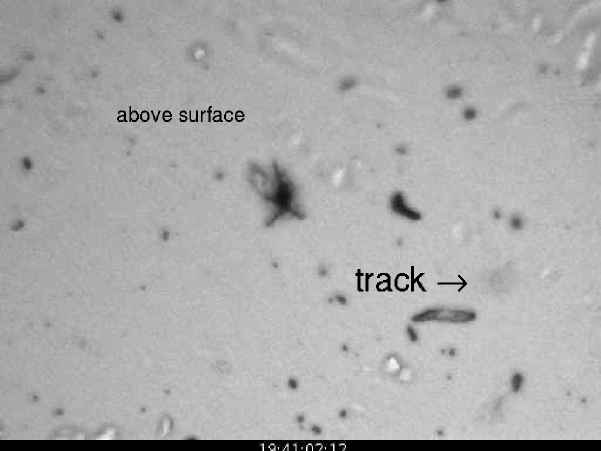
Stardust@home
Encyclopedia

Citizen science
Citizen science is a term used for the systematic collection and analysis of data; development of technology; testing of natural phenomena; and the dissemination of these activities by researchers on a primarily avocational basis...
project that encourages volunteers to search images for tiny interstellar dust impacts. The project began providing data for analysis on August 1, 2006.
From February to May 2000 and from August to December 2002, the Stardust
Stardust (spacecraft)
Stardust is a 300-kilogram robotic space probe launched by NASA on February 7, 1999 to study the asteroid 5535 Annefrank and collect samples from the coma of comet Wild 2. The primary mission was completed January 15, 2006, when the sample return capsule returned to Earth...
spacecraft exposed its "Stardust Interstellar Dust Collector" (SIDC), a set of aerogel
Aerogel
Aerogel is a synthetic porous material derived from a gel, in which the liquid component of the gel has been replaced with a gas. The result is a solid with extremely low density and thermal conductivity...
blocks about 0.1 m² (1 ft²) in total size, to interstellar dust. The collector media consist of 130 blocks of 1 and 3 cm thick silica-based aerogel mounted in aluminum cells.
In order to spot impacts of interstellar dust, just over 700,000 individual fields of the aerogel will have to be visually inspected using large magnification. Each field, which is composed of 40 images, will thus be termed a "focus movie." Stardust@home will try to achieve this by distributing the work among volunteers. Unlike distributed computing
Distributed computing
Distributed computing is a field of computer science that studies distributed systems. A distributed system consists of multiple autonomous computers that communicate through a computer network. The computers interact with each other in order to achieve a common goal...
projects, it does not try to harness the processing power of many computers. It uses them only to distribute and present the tasks to humans. This approach is similar to the earlier Clickworkers
Clickworkers
ClickWorkers is a small NASA experimental project that uses public volunteers for scientific tasks that require human perception and common sense, but not a lot of scientific training...
project to find Martian craters.
Participants must pass a test to qualify to register to participate. After registering and passing the test, participants have access to the web-based "virtual microscope" which allows them to search each field for interstellar dust impacts by focusing up and down with a focus control.
As an incentive for volunteers, Stardust@home will allow the first individual to discover a particular interstellar dust particle to name it. Also, the discoverer will appear as a co-author on any scientific paper announcing the discovery of the particle.

See also
- Citizen scienceCitizen scienceCitizen science is a term used for the systematic collection and analysis of data; development of technology; testing of natural phenomena; and the dissemination of these activities by researchers on a primarily avocational basis...
- ClickworkersClickworkersClickWorkers is a small NASA experimental project that uses public volunteers for scientific tasks that require human perception and common sense, but not a lot of scientific training...
- CrowdsourcingCrowdsourcingCrowdsourcing is the act of sourcing tasks traditionally performed by specific individuals to a group of people or community through an open call....
- Distributed ProofreadersDistributed ProofreadersDistributed Proofreaders is a web-based project that supports the development of e-texts for Project Gutenberg by allowing many people to work together in proofreading drafts of e-texts for errors.- History :...
- ZooniverseZooniverse (citizen science project)Zooniverse is a citizen science web portal that grew from the original Galaxy Zoo project. It hosts numerous projects which allow users to participate in scientific research from classifying galaxies to collating climate data...
- Galaxy ZooGalaxy ZooGalaxy Zoo is an online astronomy project which invites members of the public to assist in the morphological classification of large numbers of galaxies. It is an example of citizen science as it enlists the help of members of the public to help in scientific research. An improved version—Galaxy...
- SETI@homeSETI@homeSETI@home is an Internet-based public volunteer computing project employing the BOINC software platform, hosted by the Space Sciences Laboratory, at the University of California, Berkeley, in the United States. SETI is an acronym for the Search for Extra-Terrestrial Intelligence...

